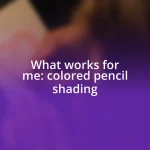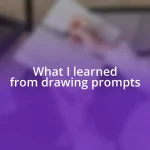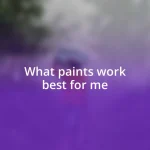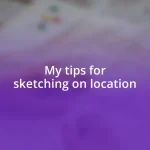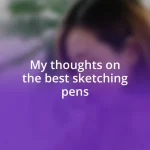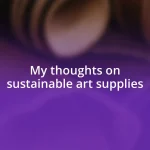Key takeaways:
- Location sketching is about capturing the essence of the environment, including sensory details that convey emotions and stories.
- Selecting essential materials simplifies the sketching process and enhances creativity, making the experience more enjoyable.
- Reviewing sketches and taking notes helps identify growth, emotional connections, and areas for improvement in one’s artistic journey.
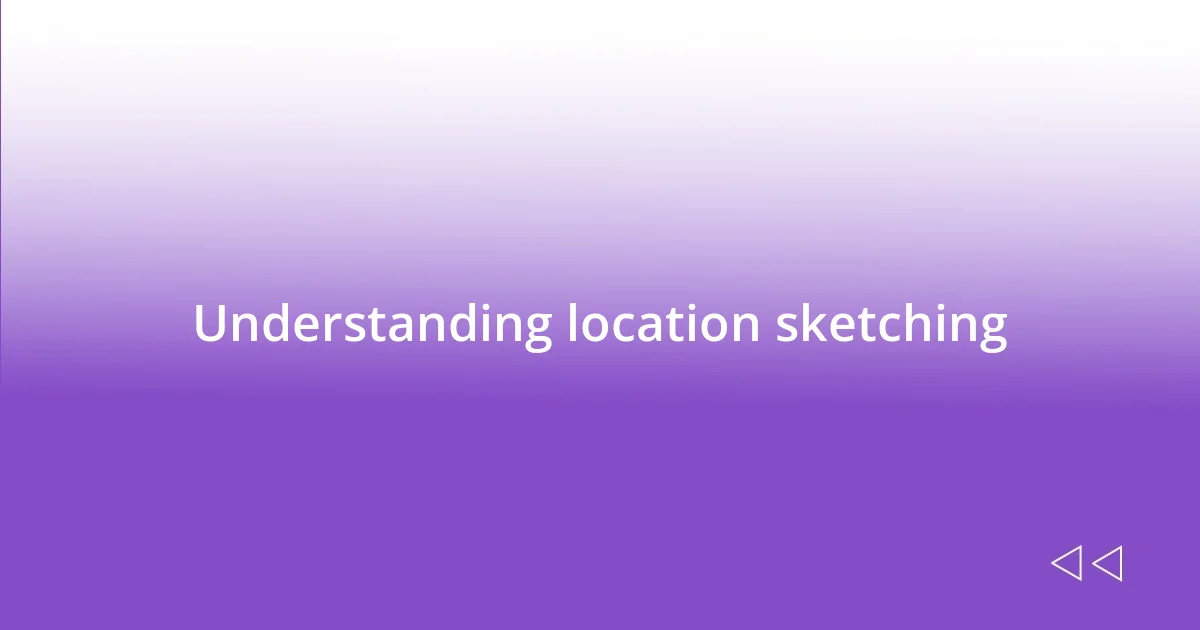
Understanding location sketching
When I first stepped outside to sketch in my neighborhood, I felt a mix of excitement and apprehension. There’s something uniquely powerful about capturing a moment in its raw, unfiltered state, don’t you think? Understanding location sketching means grasping the essence of your surroundings; it’s not just about the buildings or the trees, but the stories they tell.
While sketching on location, I often find that the atmosphere plays a crucial role. The chatter of a nearby café, the rustle of leaves in the wind—these sounds influence my sketching experience. Have you ever noticed how the mood of a place can change your perspective? When I relaxed and embraced these sensory details, it transformed my sketches into vibrant narratives.
I remember a day in the park, watching children play and feeling the warmth of the sun as I doodled. Each pencil stroke was laced with the laughter around me. This engagement deepens my understanding of the scene, allowing me to convey more than just shapes on paper; it’s about capturing the life within them. What will you discover about your own environment as you put pencil to paper?
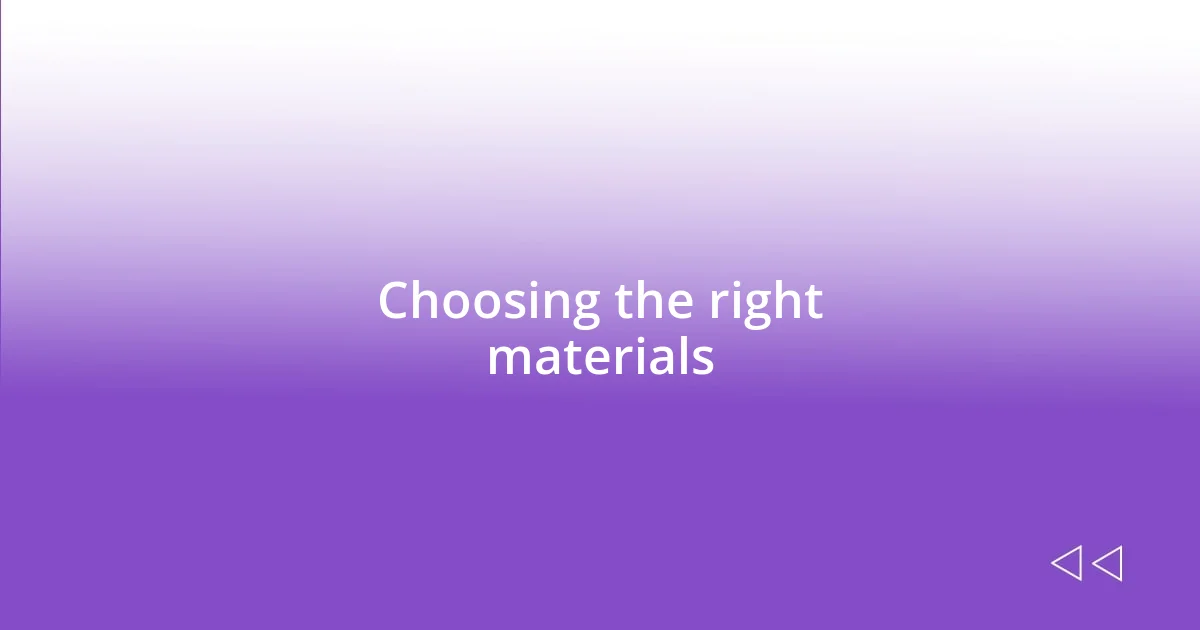
Choosing the right materials
Choosing the right materials can make all the difference in your sketching experience. I once ventured out with a heavy bag filled with every art supply I owned. It felt overwhelming, and I ended up using only a fraction of what I brought. I’ve learned that selecting a few essential items that cater to your style and the environment makes the process more enjoyable. Simplicity often enhances creativity.
Consider these materials for your next urban sketching outing:
- Sketchbook: Pick one that’s portable and has good paper quality. I love using a spiral-bound book for easy page flipping.
- Pencils: Bring a range of graphite pencils. My favorite is a mechanical pencil for fine lines and quick details.
- Watercolors: A compact watercolor set helps me add vibrancy without carrying too much weight.
- Brush: I prefer a travel-sized brush that can handle both detail and washes.
- Pen: A waterproof fineliner ensures my inked lines stay intact, even after adding watercolors.
- Eraser: A good eraser can be your best friend when you want to refine your work. I always keep a kneaded eraser handy.
By carefully selecting your materials, you create a more focused and enjoyable sketching experience that resonates with your surroundings and your personal style.
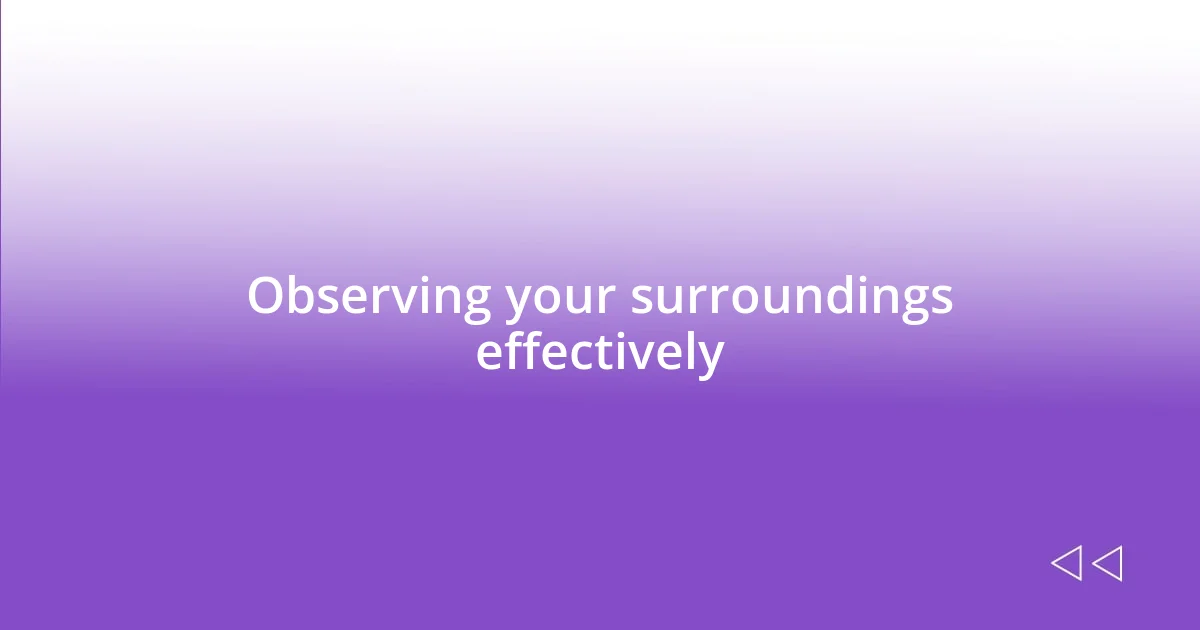
Observing your surroundings effectively
Observing the world around me is often the most thrilling part of sketching on location. One strategy I’ve found particularly helpful is to take a moment just to breathe and soak in the environment before I even put pencil to paper. I remember sitting in a bustling city square, feeling the pulse of people rushing by while I focused on the soft rustling of a nearby fountain. Taking that initial moment to observe not only grounds me but also sharpens my awareness of the details that beg to be captured, enhancing the story I want to tell through my sketches.
As I hone my observational skills, I rely heavily on a technique I call “the three-minute rule.” After settling into a location, I’ll spend three minutes just watching—really watching. In that time, I often spot subtle interactions or shifts in light that I might have overlooked if I’d jumped straight into drawing. I’ll never forget how, during one of these sessions, I noticed a couple laughing as they shared ice cream, their sheer joy becoming the highlight of my sketch. It reinforced how life’s fleeting moments, if observed with intention, can spark inspiration and bring depth to my work.
Documentation is another method that has drastically improved my observation skills. I always carry along a small notepad where I jot down sensory notes or quick sketches of interesting shapes or movements I see around me. One memorable afternoon, in a garden full of vibrant flowers, I scribbled about the sounds of bees buzzing and children playing nearby. This practice helps me remember not just what I saw, but what I felt in that moment, making my sketches come alive with emotion.
| Observation Techniques | Description |
|---|---|
| Initial Breathing | Taking a moment to absorb your surroundings to deepen your awareness before sketching. |
| Three-Minute Rule | Spending three minutes observing interactions and subtle details to inspire sketches. |
| Documentation | Jotting down notes about sensory experiences to enrich your sketches with emotions and stories. |
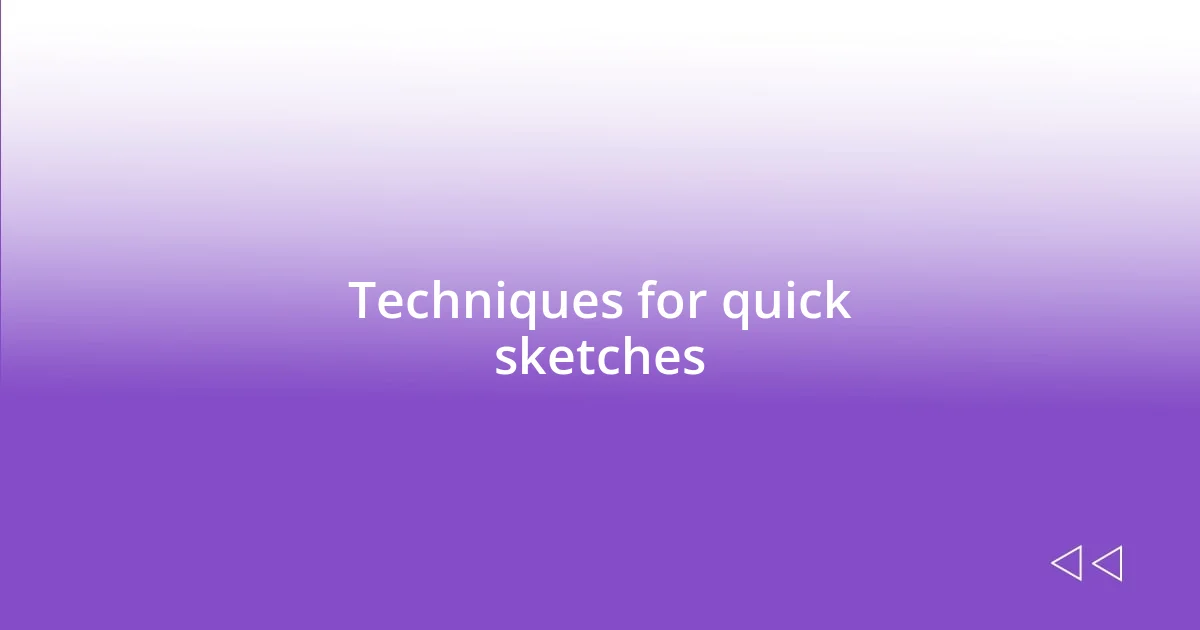
Techniques for quick sketches
When it comes to quick sketches, embracing a loose and fluid style can truly transform your experience. I remember one sunny afternoon when I decided to sketch in a park. Instead of fretting over details, I focused on capturing the essence of the scene with broad strokes. By letting my hand move freely, I felt a sense of liberation, as if I were dancing across the page rather than laboring over it. This technique not only sped up my sketching process but also injected a sense of spontaneity, turning my work into a lively interpretation of the moment.
Another technique I’ve found invaluable is to use a limited palette. In a bustling market, I grabbed just three colors to depict the vibrant stalls around me. With fewer choices, I focused on mixing those shades instinctively, resulting in a cohesive piece that felt energetic and alive. Have you ever noticed how limitations can push you to be more creative? In this case, working within boundaries helped me concentrate on shapes and forms rather than getting lost in the minutiae of colors.
Utilizing gesture drawing is another method I swear by for quick sketches. I often set a timer for just a couple of minutes to draw a figure or scene. One time, while observing a dancer rehearsing in the street, I scribbled down her movements in a series of swift lines. The result was rough, but full of motion and life—just as I felt while watching her. It’s exhilarating to capture movement this way, and it reminds me that the goal isn’t perfection; it’s all about creating a connection with what’s in front of you. Isn’t that what sketching is really about? Capturing fleeting moments and memories that might otherwise slip away?
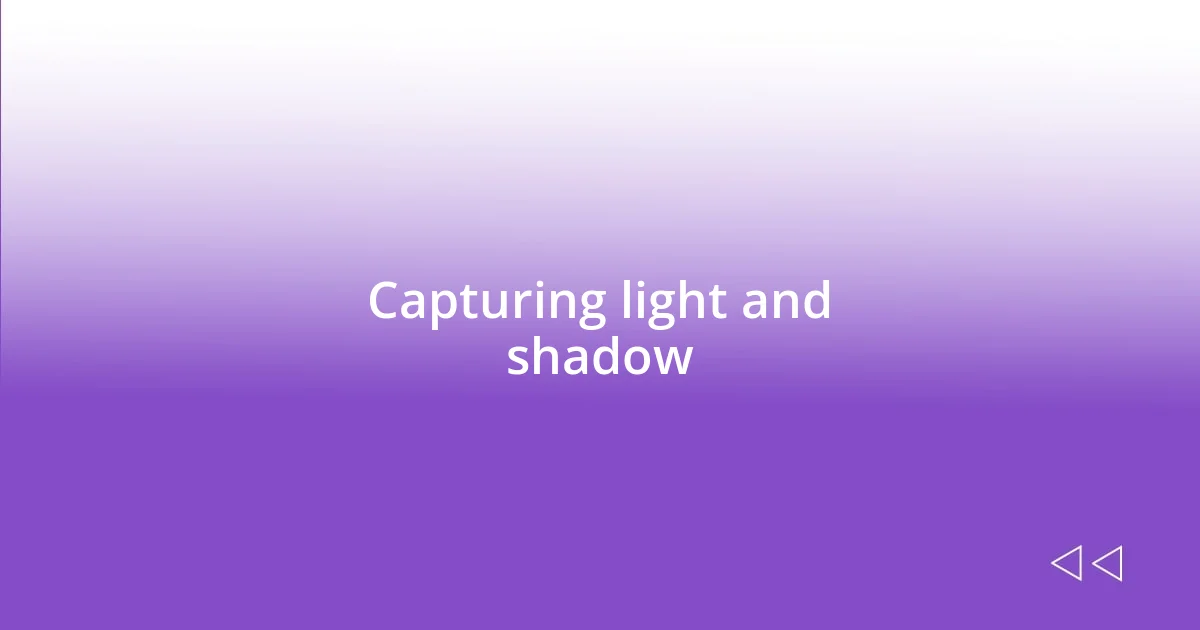
Capturing light and shadow
Paying attention to light and shadow has become one of my favorite aspects of sketching on location. I recall a chilly morning at the beach when the golden sunrise spilled warm hues across the cool blue waters, casting dynamic shadows of the dunes. Observing how the light changed the landscape in real-time sparked a realization: shadows add depth and contrast, breathing life into my sketches. It’s almost magical to watch as light transforms mundane scenes into something rich and layered.
When sketching, I often find myself experimenting with different techniques to capture these elements. One time, at a bustling outdoor café, I decided to use hatching—parallel lines that create the illusion of shadow. It was fascinating to see how simple strokes could evoke a sense of three-dimensionality. Have you ever played with light in your drawings? I remember feeling a rush of excitement as I brought a flat image to life, simply by paying attention to where the light hit my subjects and where it refrained.
It’s not just about visual representation; it’s also about conveying the mood of the moment. A rainy day can cast a somber tone, while bright sunlight elevates the energy. When sketching a lively street fair under the sun, I noticed how the strong contrasts created by deep shadows behind vibrant stalls highlighted their colors. It made me think: how often do we overlook the way light influences our emotions and perceptions? I learned to embrace those differences in my work, translating not just what I see, but how the light made me feel in that vibrant setting.
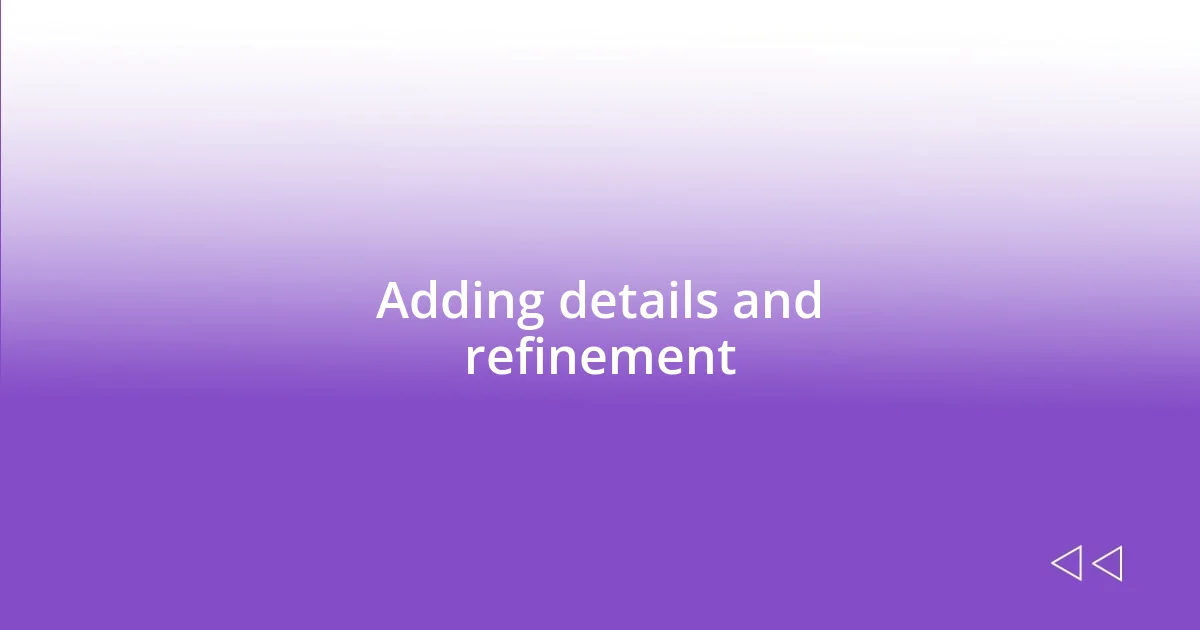
Adding details and refinement
Adding intricate details can truly lift a sketch from ordinary to extraordinary. I remember sitting on a busy street corner, where I spent a good ten minutes just observing a flower shop. As a friend strolled by and asked what I was doing, it clicked for me: I wasn’t merely sketching; I was choosing which petals to highlight, which textures to emphasize. Have you ever poured over a seemingly simple subject and found layers of complexity? That’s what I discovered—each stroke added nuance and character, enriching the composition.
When refining my sketches, I often zoom in on one or two specific elements that resonate with me. There was a moment at a vibrant farmers’ market when I focused entirely on an ornate basket of ripe strawberries. Instead of detailing every berry, I emphasized the exquisite curves of the basket and the way light danced off those shiny red surfaces. It’s surprising how pulling back on some details and honing in on others can create a powerful focal point. Why do we often forget that less can be more in art?
I also believe in revisiting my sketches after a break to add those final touches. After a day of sketching at a festival, I took my drawings home and put them away for a few hours. When I returned, I was able to see fresh opportunities for improvement. Adding a splash of color here, refining a line there—it’s like giving my work a second chance to blossom. Has there been a time when stepping away allowed you to see your own work differently? I have found that these moments of distance often lead to the most rewarding refinements, revealing the heart of the scene I tried to capture.

Reviewing and learning from sketches
Reviewing my sketches is like opening a diary filled with memories and insights. One afternoon, while I was sketching at a local park, I paused to look back over my earlier drawings. I noticed how the little mistakes—off proportions or awkward angles—taught me the most about my process. Have you ever felt that way about your work? It struck me that those imperfections weren’t failures; they were stepping stones towards improvement. Each experience adds a layer of understanding that helps me grow as an artist.
I find it valuable to set aside time specifically to assess my sketches, almost like a mini-review session. Recently, after a day of sketching a bustling market, I gathered my pieces and laid them out on my desk. I could see common themes emerging—the way colors played out, or perhaps how the energy of the scene influenced my technique. It was enlightening to notice that the sketches I enjoyed the most were the ones where I felt emotionally connected to the moment. Have you ever critically looked at your work and been surprised by what resonated with you? I learned that the sketches that evoke feelings hold a special power, adding depth to my artistic voice.
Taking notes alongside my sketches has become a cherished practice. I recall sketching an elderly man playing chess in the park. Afterward, I jotted down my thoughts: the soft wrinkles on his face, the intense focus of his eyes. This reflection not only helped me appreciate the moment further but also guided my approach in future sketches. How often do we capture the moment but forget to record the feelings behind it? By reviewing my sketches and my notes, I’m continuously learning to weave emotion into my art, turning a simple representation into a story worth telling.

